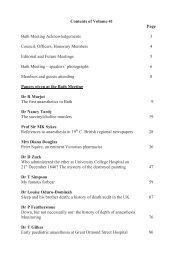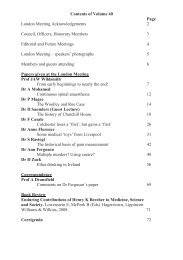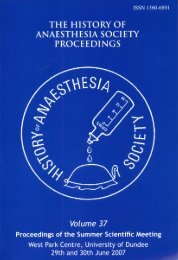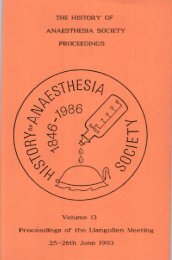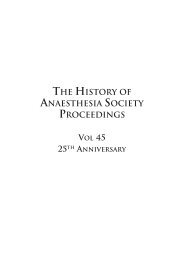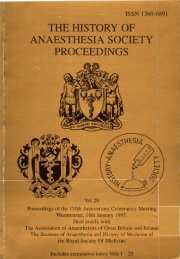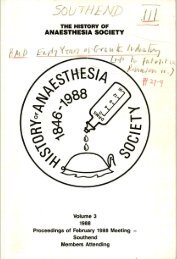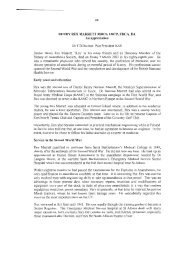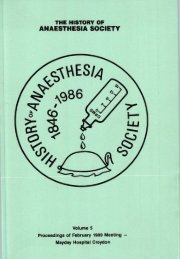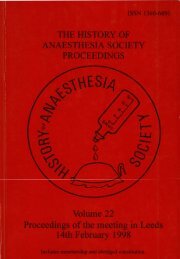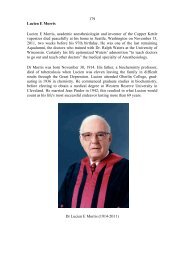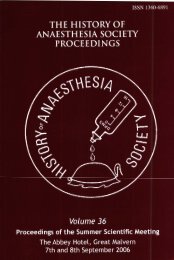Volume 7 - History of Anaesthesia Society
Volume 7 - History of Anaesthesia Society
Volume 7 - History of Anaesthesia Society
Create successful ePaper yourself
Turn your PDF publications into a flip-book with our unique Google optimized e-Paper software.
much less relaxant was required and most patients were returned to<br />
intensive care extubated and breathing spontaneously. I have not<br />
mentioned heparin or protarnine but, <strong>of</strong> course, these are required in all<br />
bypass cases.<br />
So far, 1 have not dealt with mechanical ventilators. In 1952 a severe<br />
outbreak oE bulbar-poliomyelitis occurred in Denrnark necessitating the<br />
ventilation <strong>of</strong> many patients for periods up Lo 6 weeks. A t that tine<br />
the only ventilator available war the 'Tron Lung' <strong>of</strong> which there were<br />
only a few in fever hospitals. The majority <strong>of</strong> the patients in the<br />
Uerunark epidemic were ventilated by hand, by relatives, friends or<br />
anyone who was avdiLable. The then Ministry <strong>of</strong> Health in this country<br />
becane anxious abut a possible outbreak here in 1953, and called a<br />
~neeting to discuss ventletory equlpnent which I was asked to attend.<br />
At that meeting, Beaver, an anaesthetist at Queen's Square, showed the<br />
small, easily produced ventilator (costing E40) which he had designed.<br />
Ehgstrom in Sweden had manufactured a very cmplicated machine at a cost<br />
<strong>of</strong> f2,500. From this edrly ver~tilator <strong>of</strong> ~eaver' S the sophisticated<br />
equipnent <strong>of</strong> today has been develuped. I, myself, had no faith in the<br />
reliability <strong>of</strong> things mechanical and ventilated every patient by hand<br />
during the 31 years in which I was involved with cardiac surgery and<br />
endeavoured in the majority <strong>of</strong> cases to return them to the intensive<br />
care unit extubated and breathing spontaneously.<br />
Cutler EC, Beck CS. Present status <strong>of</strong> the surgical procedures in<br />
chronic valvular disease <strong>of</strong> the heart. Archives <strong>of</strong> Surgery<br />
1929; 18:403.<br />
Campbell M. Tne early operations for mitral stenosis. British<br />
Heart Journal 1365; 27:670.<br />
Ellis RH. The first trans-auricular mitral valvotomy.<br />
<strong>Anaesthesia</strong> 1975; 33:374.<br />
Ship~sy FE. The advantage oE warmed anaesthetic vapours and<br />
an apparatus fur their administration. Lancet 1916; 1:70.<br />
Nosworthy M). <strong>Anaesthesia</strong> in chest surgery with special reference<br />
to controlled respiration and cyclopropane. Proceedings oE the<br />
Royal <strong>Society</strong> <strong>of</strong> Yedicine 1941; 34:479.<br />
Cuedel M, Waters LW. New intratracheal catheter. Anesthesia<br />
and Analgesia (Current Researches) 1928; 7: 238.<br />
Gray TC, Halton J. A milestone in anaesthesia? (d-tubocurarine<br />
chloride). Proceedings oE the Royal <strong>Society</strong> <strong>of</strong> Medicine 1946;<br />
39:400.<br />
Blalock A, Taussig 133. Surgical treatment <strong>of</strong> malfomtion <strong>of</strong><br />
heart in rrhich there is ~ulrnonarv stenosis or oulmonarv atresia.<br />
Journal <strong>of</strong> the American hedical Association l9&5; 128:i89.<br />
Rink EH. Aelliwell PJ. Hutton AM. <strong>Anaesthesia</strong> Eor oaerations for<br />
the relief <strong>of</strong> congenital pulmonary stenosis. G U ~ Hospital<br />
' ~<br />
Reports 1948; 97:48.<br />
Baker C, Brock RC, Campbell M. Valcrulotomy Eor mitral stenosis;<br />
report <strong>of</strong> G successful cases. Brit.ish Medical Journal 1950;<br />
1:1283.



